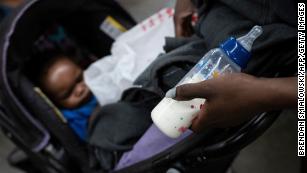When her daughter was born, a mom, who I'll call Dana, couldn't afford to take more than two weeks off work. Working as a school bus driver and earning about $18,000 a year, Dana was her family's breadwinner -- but her employer didn't grant her any paid leave. I first met Dana in 2018 when my research team and I were recruiting pregnant patients at prenatal clinics in Indiana for a study of parenting plans.

Jessica Calarco
Dana initially hoped to breastfeed her daughter for over a year, but going back to work made that goal difficult and often painful to achieve. To work her bus shift, Dana had to wake up before 5 a.m., while her daughter was still asleep, and by the time she got home later in the morning, her breasts would feel ready to burst.
"I would get super full," Dana recalled, "I'd come home and immediately have to nurse." By that point in the morning, however, Dana's husband had usually put their daughter back down for a nap. So, Dana would let her 2-year-old son nurse for a while to relieve the pressure, then pump additional milk for her husband to give the baby when she went back to work her second shift in the afternoon.
That combination of breastfeeding and pumping, meanwhile, led Dana's breasts to produce more milk, which meant they would be even fuller and more painful by the time she got home again in the evening. This, in turn, exacerbated the postpartum depression Dana experienced.
Given her low income, she could have qualified for Special Supplemental Nutrition Program for Women, Infants, and Children (WIC) benefits, which cover formula for new babies. But, as Dana explained, "I felt like I didn't deserve to be in WIC because I co-slept," a sleeping arrangement that WIC advised against.
The American Academy of Pediatrics (AAP) acknowledges parents like Dana face "structural barriers to breastfeeding" and to meeting its new guidelines, which recommend lactating parents breastfeed or "chestfeed" (a term inclusive of gender diverse families) their infants exclusively through the first six months of life, and continue to do so alongside other feeding options through two years of age.

Companies aggressively marketed baby formula. Then there was a shortage
Speaking to employers, policymakers, and health care professionals, the new guidelines note that: "Policies that protect breastfeeding, including universal paid maternity leave; the right of a woman to breastfeed in public; insurance coverage for lactation support and breast pumps; on-site child care; universal workplace break time with a clean, private location for expressing milk; the right to feed expressed milk; and the right to breastfeed in child care centers and lactation rooms in schools are all essential to supporting families in sustaining breastfeeding."
Addressing these structural barriers to breastfeeding would help lactating parents like Dana. Yet, given what my team and I found in our research, I would also argue that the AAP's recommendations for employers, policymakers and health care professionals do not go far enough to call for support for parents who want to breastfeed or chestfeed their infants -- or to offer reassurance to parents who struggle to meet the AAP's goals.
An employer can follow the guidelines -- and it's still not enough
The AAP guidelines don't sufficiently challenge worker norms based on White men with stay-at-home partners -- norms that require workers to sacrifice their bodies and their relationships with their families for their employers' gain.
To see what I mean here, consider another mother, who I'll call Gina. As a lawyer working long hours and earning $70,000 a year, she was able to take three months of paid leave after her daughter was born, and was able to breastfeed almost exclusively during that time. When Gina returned to the office, however, she struggled to find time for pumping amid all her work demands.

With formula in short supply, moms are pumping breast milk to help others
"I have my own office with a door... I have an understanding boss... It's sort of an ideal setup in some ways, but it's still just so hard to find the time," she explained. "Like, I gotta leave this meeting now 'cus I have to go do this. That's been unexpectedly hard."
Gina also felt pressured to do something productive during her pumping time. As she explained: "I can't take thirty minutes three times a day and do no work during that time and then still get home at a decent time."
According to the AAP guidelines, Gina's employer did everything right; yet, and despite her initial plans to exclusively breastfeed for at least nine months, Gina ended up supplementing with formula and then weaning off breastfeeding completely after six months.
Universal health care as an essential part of lactation support
While some women may have no problem breastfeeding without guidance from a health care provider, many others struggle. Universal health care, including lactation support, should be championed by the AAP, as it would help these mothers find their way in feeding their newborns.
To that end, take the experience of another mother who I'll call Erin. When her first child was born, she was working a minimum wage job at a grocery store, did not have access to employer-provided health insurance, and couldn't afford to purchase it on her own. Erin tried to use health care as sparingly as possible, but that became a problem when her son struggled to latch properly during breastfeeding. This meant that she had to spend hours a day breastfeeding because her son wasn't getting enough to eat. This left her with cracked, bleeding nipples.
Eventually, a lactation consultant told Erin that her son needed a procedure to correct a "tongue tie" -- when the skin that ties the tongue to the floor of a baby's mouth is so short that it is difficult to get a good latch during breastfeeding. Erin took her son to a specialist, who told her the surgery, without insurance, would cost $1,000 -- money Erin did not have. The specialist encouraged Erin to sign up for Medicaid, but by the time the paperwork went through and they were able to do the surgery, Erin's milk had dried up.
The stigma of failing to breastfeed
The AAP guidelines also fail to emphasize that it's OK if parents opt not to breastfeed or chestfeed for personal reasons -- like past abuse or trauma -- or because of physical challenges, including inverted nipples, shallow latches, tongue ties, milk blisters, mastitis, painful engorgement and undersupply.
These were just some of the common but painful problems that mothers we interviewed described and that led them to either stop breastfeeding or to plan not to breastfeed their younger children after trying with their older kids.
Consider a mom I'll call Beverly, who opted not to breastfeed her younger two children after struggling to breastfeed her oldest son. As Beverly explained: "My milk supply never came in... I was dry before I left the hospital and nothing came in, period." The new AAP guidelines make almost no mention of the struggles faced by parents like Beverly, except to encourage the one-third of postpartum parents who experience mastitis to continue nursing through the pain. In doing so, the AAP may inadvertently contribute to the postpartum depression and anxiety that many birthing parents in the US currently face.
Dana, Gina, Erin and Beverly all experienced mental health struggles after giving birth to their babies and all connected those struggles, at least in part, to the difficulties they faced in breastfeeding the way they had planned. These women believed that, to be good mothers, they had to breastfeed -- and to keep breastfeeding through barriers and pain. When they struggled to meet those goals, they experienced self-doubt and self-blame.
The AAP could avoid exacerbating these mental health struggles by offering stronger recommendations for employers, policymakers and health care professionals and by extending reassurance to parents who struggle to follow the AAP rules.
Breastfeeding and chestfeeding may have some benefits for both babies and lactating parents. Yet, the AAP's claims about the benefits of extended breastfeeding are based primarily on correlational evidence. Existing research can only say that the kinds of families who are able to follow the AAP's guidelines have better health outcomes, not that following those guidelines would actually improve outcomes for families who are currently falling short.
If the AAP's real end goal is to improve health outcomes for babies and for postpartum parents, then future guidelines should emphasize to postpartum parents: If breastfeeding or chestfeeding doesn't work for you and your family, it's not your fault and it's OK.




